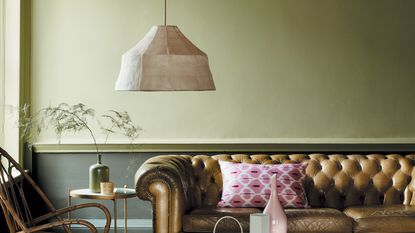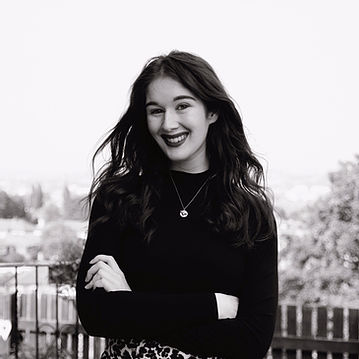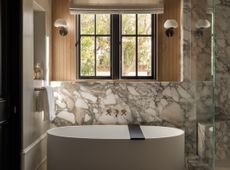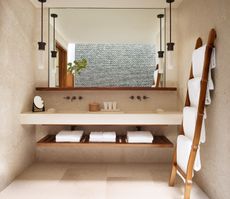Is color psychology changing the way we decorate? The new wellness trend taking over our homes
Designers respond to the scientific movement – and share how to spark positivity through paint


Color psychology – the study of hues and their relationship to our wellbeing – has seen a sharp increase in recent seasons. But this color trend shows no signs of slowing down.
A recent investigation* reported a 215.78% rise in Google searches for color psychology – meaning the movement will continue to make waves in the interiors industry long into 2022.
'There is an ever-growing recognition that interiors color choices directly impact the atmosphere of the space they inhabit and the energy of those that experience them,' explains Jean Frédéric Nothomb, founder of the Parisian paint label Argile.

Color psychology certainly isn't going away. So, we sat down with the individuals who are responsible for reshaping paint ideas to discuss their reactions to the movement. And science meets design; the experts have a lot to say.
Why has the interest increased?
'Over the past year, we have all had a chance to reflect on what's important in life: health, wellbeing, and our environment have certainly moved to the forefront in people's minds,' explains the Creative Director at Little Greene, Ruth Mottershead.
'The renewed interest in color psychology is a natural extension of that desire to surround ourselves with colors that elicit a positive feeling,' she adds.

Should we follow color psychology?
Color psychology has emerged as one of the biggest interior design trends – but do the paint experts recommend joining the color revolution?
'Rather than following trends, it's important to choose colors and patterns that speak to you, be that to make you feel happy and energized or tranquil and serene, your color choices should feel personal to you,' Ruth says.
And, while different colors speak to different people, the trend is fueling the desire to uncover the tones that make your happiest, as Ruth suggests: 'We are seeing that people are really recognizing that the colors they choose to surround themselves with are key to determining how a space will make them feel.'

Color and Paint Expert Annie Sloan agrees with Ruth – suggesting you should only choose tones that evoke personal emotion – rather than what you should like.
'Color psychology is a flawed concept because color is a deeply personal thing,' Annie says. 'It's far better to look at colors in terms of whether they're active and dynamic or serene and calming, as these traits are less subjective.'
Which tones do the experts recommend?
As Annie and Ruth suggest, your reaction to color is highly personal. However, these are the shades that are most likely to provoke joy throughout your interiors.
'Use bright, bold, active colors in social spaces like kitchens or living rooms and calming, earth-toned shades in bathrooms and bedrooms,' Annie suggests. 'A color clash will always put me in a good mood because it feels cheeky, daring, and mischievous and heightens the qualities of each color to fabulous effect.'
Plus, Jean recommends turning to colors that derive from nature for their calm and tranquil qualities. However, 'this goes beyond having a blue bedroom.'

'It's depth, subtlety, and texture is what allows you to truly experience the color [that surrounds you],' they explain.
Will science fuel your next paint project? We expect this wellness trend will be big news for the seasons ahead.
*Google Trends study by MyJobQuote.
Be The First To Know
The Livingetc newsletter is your shortcut to the now and the next in home design. Subscribe today to receive a stunning free 200-page book of the best homes from around the world.
Megan is the News and Trends Editor at Homes & Gardens. She first joined Future Plc as a News Writer across their interiors titles, including Livingetc and Real Homes. As the News Editor, she often focuses on emerging microtrends, well-being stories, and celebrity-focused pieces.
Before joining Future, Megan worked as a News Explainer at The Telegraph, following her MA in International Journalism at the University of Leeds. During her BA in English Literature and Creative Writing, she gained writing experience in the US whilst studying in New York. Megan also focused on travel writing during her time living in Paris, where she produced content for a French travel site.
-
 5 Things People With Flattering Bathrooms Never Have — (And You Shouldn't Either!)
5 Things People With Flattering Bathrooms Never Have — (And You Shouldn't Either!)Designers say you should avoid these five things if you want a bathroom that flatters your reflection and therefore uplifts your mood
By Oonagh Turner Published
-
 How to Organize your Bathroom for a Better Morning Routine — 6 Steps for a Seamless Start to the Day
How to Organize your Bathroom for a Better Morning Routine — 6 Steps for a Seamless Start to the DayThe ease of your morning routine can have a huge influence over the rest of the day, so make sure you optimize you space for a stress-free start to the day
By Lilith Hudson Published

